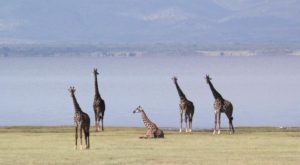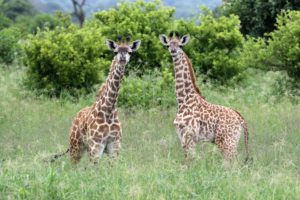Female Masai giraffes live in distinct social communities of up to 90 other friends, and although areas used by these ‘girl gangs’ often overlap, they have very different rates of reproduction and calf survival. This means the girl gang social units may be important to giraffe evolution. These findings were published this week in the Journal of Wildlife Management by a team of scientists from the Population Ecology group at University of Zurich and Penn State University, as part of one of the largest giraffe studies in the world. “We used social network analysis of hundreds of females and discovered this girl gang social organization from the giraffe’s own preference and avoidance behaviors,” said Derek Lee, associate research professor at Penn State and senior author of the study. “Gang membership was pretty tight, and even though members of different girl gangs often spent time in the same areas, members of different communities rarely interacted with each other.”
The scientists further found that calf survival and reproductive rates were different among these social communities, even when communities’ home ranges overlapped in space and therefore shared similar environmental conditions. “This shows that population structure can arise from social behavior rather than discrete space use,” noted Monica Bond, lead author and research associate at the University of Zurich. “These social subpopulations have different survival and reproductive rates, so some might have greater competitive abilities than others, like being able to dominate the better-quality food, or there might be cultural differences such as having better strategies for protecting their calves from predators.”
Each giraffe social community exhibited different social characteristics, like how strong the relationships were among the community members. There was also a gradient in environmental characteristics in which the giraffe communities lived: the Tarangire region of northern Tanzania where the study occurred includes two national parks, a livestock and ecotourism ranch, and unprotected lands inhabited by traditional cattle ranchers, as well as several densely populated towns surrounded by agricultural lands. The scientists wondered how the environmental or social conditions experienced by the giraffes might influence their survival and reproduction. “Survival and reproduction together determine whether a wildlife population (or subpopulation like a specific girl gang) increases or decreases and is therefore absolutely critical for conservation,” said Lee.
The team calculated the survival rates of more than 1,400 adult females and calves, and the annual number of calves per female, and examined if there were differences among the social communities. They then investigated if the differences were explained by social factors like the strength of relationships, or by features of the environment, such as how close to people the giraffes roamed, the fertility of the soils, or the kind of vegetation in their ranges.
Giraffe calf survival was higher in social communities that had less area of dense bushlands in their ranges, possibly because lions prefer to hunt in such thickets where they can stalk their prey unseen. “We also found that calf survival and reproductive rates were higher in the social communities that spent more time outside of the national parks,” said Bond, probably also because there are fewer natural predators like lions and hyenas near where people live. Some areas outside the parks also had more fertile volcanic soils and therefore possibly more nutritious food than on other soil types.
“The good news for conservation is that giraffes can survive and raise their offspring in areas close to people,” Lee pointed out. “We can help giraffes to thrive by giving them enough living space in the savanna—both inside and outside of national parks—and by taking care not to disturb them and disrupt their social relationships.”


